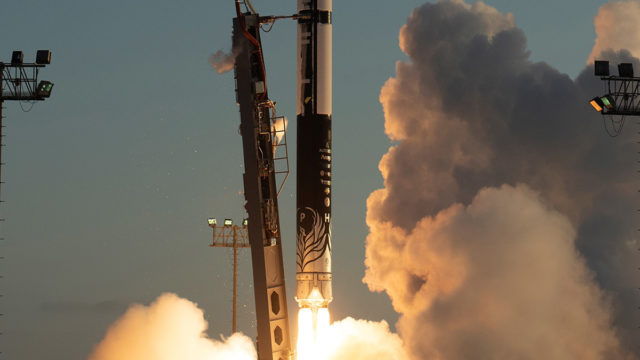
Ukraine Expanding Space Program, Plans 2022 Moon Launch
Publication: Eurasia Daily Monitor Volume: 18 Issue: 152
By:

Interest in privatizing space operations by Western companies such as SpaceX and Virgin Galactic has now reached the former Soviet republic of Ukraine, which, for the moment, is focused on technological payloads rather than manned spaceflight. Unfortunately for advocates of Ukraine’s aerospace capabilities, on September 2, a Ukrainian-American rocket exploded two minutes into a test flight launch from Vandenberg Space Base in California (Channel 9, September 3).
The two-stage “Alpha” rocket was primarily manufactured by Firefly Aerospace’s Austin, Texas, facility, with some propulsion components from Ukraine’s Pivdenmash (Yuzmash) state-run space enterprise, based in Dnipro. Firefly Aerospace is owned by Ukrainian businessman Max Poliakov. The Alpha was intended to go into orbit 186 miles (300 kilometers) up; but when one of the four first-stage engines temporarily stopped working due to a valve failure in the fuel system, the team monitors decided to interrupt the launch by detonating the rocket (Ekonomichna Pravda, September 7).
On August 18, two weeks before the unsuccessful launch, static firing tests of the two-stage American-Ukrainian Alpha vehicle were conducted at the Vandenberg Air Force Base launch site in Lompoc, California, during which the rocket’s first stage engines fired as planned for 15 seconds (Lenta, August 21). The next day, a 37-second video of the successful test was uploaded by Firefly Aerospace onto YouTube (YouTube, August 19).
This is not Ukraine’s sole new space effort. Spacebit, a company founded by Ukrainian Pavlo Tanasiuk, in cooperation with its partners in the United States, plans to send a mission to the moon in 2022. The probe will be equipped with scientific research equipment manufactured in Ukraine (Channel 9, August 31).
These missions will allow Ukraine to join the elite club of advanced-technology countries capable of delivering cargo to the moon. At the same time, these efforts aim to revive Ukraine’s historic role as a space-faring state and to provide a basis from which to develop future domestic space projects in collaboration with the public sector by utilizing components of the country’s Soviet-legacy aerospace industry. Nonplussed by the September 2 test flight’s termination, Firefly Aerospace subsequently announced that a second Alpha rocket trial will take place in December (Ekonomichna Pravda, September 15).
Since the 1991 implosion of the Soviet Union, the Ukrainian government has made sustained efforts to retain essential components of its Communist-era industrial infrastructure, particularly in armaments and technology production. A concurrent common theme running through the past three decades has been Kyiv’s relentless search for foreign direct investment (FDI), which has up to now produced rather uneven results. While Ukraine’s aerospace sector has been particularly interested in collaboration with the US National Aeronautics and Space Administration (NASA), sufficient funding, has remained elusive (see EDM, March 5, 2019). Employment issues are also of concern, as Ukraine’s Dnipro-based space industry provides careers for more than 11,000 highly-qualified technicians (see EDM, April 13, 2020).
Despite setbacks, the Ukrainian aerospace sector is optimistic that such technological and funding issues can be resolved. In August 2021, Ukraine’s State Space Agency head, Volodymyr Taftai, announced the upcoming launch of the Ukrainian Cyclone-4M rocket, scheduled to occur in 2022 from a launch facility in Canada (Lenta, August 9). Taftai said, “For Ukraine, such work is of great importance because in this case we are talking about the actual revival of full-fledged rocket and missile technology in Ukraine and the return to the club of space countries of the world without the participation of Russia” (Defence-ua.com, August 6). Taftai added that his agency expects to approve a five-year space program with appropriate funding by the end of this year, allowing not only the construction and launch of the Cyclone-4M but also development and building of an indigenous Ukrainian orbital group of satellites.
An inevitable consideration tempering Ukraine’s optimism, however, is that the country’s space ambitions lack an integral component to achieve full aerospace independence: launch sites. Given the astronomical construction costs of such facilities, the Ukrainian government is unlikely to approve such an outlay any time soon. Furthermore, as the country’s space program is expressly designed to assure independence from collaboration with Russia and its space facilities, it remains extremely unlike any of the post-Soviet states with launch facilities, such as Kazakhstan with its Baikonur Cosmodrome, would be willing to assist Ukraine, leaving it completely dependent on European and North American facilities. While the Firefly Aerospace test launch demonstrates Ukraine’s aerospace potential, strained relations with its giant northeastern neighbor must of necessity factor into the considerations of foreign investors.
Firefly Aerospace is confident that its technological issues can be resolved; according to Poliakov, the company intends in the future to launch 8 to 24 rockets per year (Ekonomichna Pravda, September 15). Whether that is an overly optimistic agenda capable of attracting significant FDI, only time will tell.



